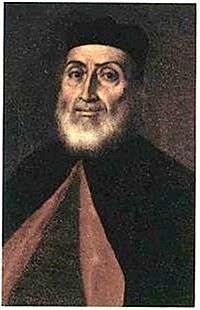Nikolaos Koutouzis


Nikolaos Koutouzis (Greek: Νικόλαος Κουτούζης; 1741, Zakynthos - 1813, Zakynthos) was a Greek painter, poet and priest who belonged to the Heptanese School of painting.[1]
Biography
He was born in a part of Greece that was under Venetian, rather than Ottoman control. He appears to have taken his first art lessons from Nikolaos Doxaras,[1] who lived on Zakynthos during the 1750s. At the age of sixteen, under his direction, Koutouzis painted decorations at the Churches of Saint John of Damascus and Saint Demetrius, both of which have since been destroyed. He may have lived in Venice from 1760 to 1764.[2] If so, he was definitely back at Zakynthos in 1766, painting the "Procession of Saint Dionysius".
He also wrote satirical poems on local affairs and scandals,[1] which often contained sharp lampoons of his contemporaries. In 1770, this led to an assault, during which he was wounded in the face.[2] To hide the scar, he grew a beard. This event is also cited as his reason for becoming a priest, but it was seven years later before he took up priestly duties on Lefkada. He subsequently became a parish priest at several locations on his native island.
Nevertheless, he continued to write satirical poetry. This, combined with what was considered a theatrical manner of conducting church services, led to clashes with his superiors and parishioners. Eventually, he was charged with ""misconduct and violation of the Orthodox ritual" and was defrocked in 1810. Three years later, some of his accusers recanted and he was reinstated, but refused to take up his duties. He died a few months later.
Although he focused on religious painting, his portraits are, perhaps, his best known work. He also took in the occasional student, most notably Nikolaos Kantounis.[2]
References
- 1 2 3 Brief biography @ Ygeia Online
- 1 2 3 Brief biography @ the National Gallery website
Further reading
- Nikolaos Koutouzis, Βωμολοχικές σάτιρες ιερέων, (satirical poems) Periplus, 1996 ISBN 978-960-7131-42-3
- Dinos Konomos, Nikolaos Koutouzis (a biographical novel), Athens, A.Karavias, 1974
External links
| Wikimedia Commons has media related to Nikolaos Koutouzis. |
- Biographical notes, with samples of his poetry, @ the Imera (Zante edition) website